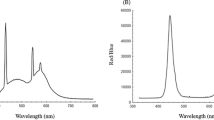Abstract
Studies were conducted to develop an efficient cutting propagation method for domestic cut roses (Rosa hybrida Hort.). Three experiments were conducted in controlled environment growth chambers to investigate the effect of node position where the cuttings were taken, and number of leaflets left on each cutting, and light intensity on rooting and growth of the sapling. Domestic cut rose cultivars used in the first experiment for the effect of node position were standard type ‘Pink Song’ and ‘Gouni’, and spray type ‘Little Sun’ and ‘May.’ In the second experiment for the effect of number of leaflets left, standard type ‘Pink Song’, ‘Orange Beauty’ and ‘Gummack’, and spray type ‘May’ were used. In the third experiment for the effect of light intensity, standard type ‘Red Sun’ and ‘Gouni’, and spray type ‘Little Sun’ and ‘May’ were used. Cuttings were taken from third node positions each with a five leaflet. Each cutting had either 1, 3, or 5 leaflets by removing the rest of leaflets among five leaflets. Three light intensities used were 90, 180, and 270 μmol·m−2·s−1. Node position only affected rooting percent. However, number of roots, root length and weight, and length of new shoot were not significantly affected by the node position. In ‘Pink Song’, ‘Little Sun’, and ‘Gouni’, the greatest rooting percent was observed in the 1–2th (top), whereas in ‘May’ it was observed 4–5th (middle) and 7–8th (bottom). Number of leaflets left on each cutting affected number of roots, root length and root weight, but not the length of new shoot and rooting percent. In ‘Gummack’, treatment with three leaflets left resulted in the greatest number of roots, length of the longest root, root weight, length of new shoot, and percent rooting. Also, similar results were observed in ‘Pink Song’, ‘May’, and ‘Orange Beauty’, except in length of new shoot. Optimum light intensity for rooting was 270 μmol·m−2·s−1 for ‘Red Sun’, ‘Little Sun’, and ‘May’. In these three cultivars, rooting percent of the cuttings increased with increasing light intensity. In ‘Gouni’, however, the optimum light intensity for rooting was 180 μmol·m−2·s−1.
Similar content being viewed by others
Literature Cited
Al-Saqri, F. and P.G. Alderson. 1996. Effects of IBA, cutting type and rooting media on rooting of Rosa centifolia. J. Hort. Sci. 71: 729–737.
Bredmose, N.B. 1998. Growth, flowering, and postharvest performance of single-stemmed rose (Rosa hybrida L.) plants in response to light quantum integral and plant population density. J. Amer. Soc. Hort. Sci. 123:569–576.
Bredmose, N. and J. Hansen. 1996. Topophysis affects the potential of axillary bud growth, fresh biomass accumulation and specific fresh weight in single stem rose (Rosa hybrida L.). Ann. Bot. 78:215–222.
Bressan P.H., Y.J. Kim, S.E. Hyndman, P.M. Hasegawa, and R.A. Bressan. 1982. Factors affecting in vitro propagation of roses. J. Amer. Soc. Hort. Sci. 107:979–990.
Chung, S.K. 1989. Effect of propagation methods and cultivars on cut flower quality and shoot development of roses (Rosa hybrida) cultivated on rockwool in winter. J. Kor. Soc. Hort. Sci. 30:45–50.
Chung, S.K., Y.J. Park, W.H. Kim, Y.N. Oh., E.K. Lee, and B.H. Kwack. 1998. Study on the growth and rooting rate of cuttings for rockwool culture of roses (Rosa hybrida). J. Kor. Soc. Hort. Sci. 39:203–206.
Cline, M.G. 1991. Apical dominance. Bot. Rev. 57:318–358.
Dubois, L.A.M. and D.P. de Vries. 1985. Research on the cuttage in ’sonia’ rose for the propagation of good cuttings. Vak. Bloem. 45:26–30.
Gad, A.E., I. Ben-Efraim, M. Yavzury, H. Weinberg, and G. Friedman. 1987. Rooting and subsequent vegetative growth of geranium cuttings improved by 4-chloro-resorcinol. Isr. J. Bot. 36:185–189.
Jensen, H.E.K. 1967. Influence of cutting position and stem length on rooting of leaf-bud cuttings of Schefflera arboricola. Sci. Hortic. 28:177–186.
Kim, G.H. and B.R. Jeong. 2006. Axillary bud position affects shoot growth of potted miniature roses in vitro. Hort. Environ. Biotechnol. 47:28–33.
Kim, W.H. 2007. Rose (Rosa hybrida Hort., Rosaceae). p. 309–312. In: J.M. Lee, G.W. Choi, and J. Janick (eds.). Horticulture in Korea. Kor. Soc. Hort. Sci., Suwon, Korea.
Kuris, A., A. Altman, and E. Putievsky. 1980. Rooting and initial establishment of stem cuttings of oregano, peppermint and balm. Sci. Hort. 13:53–59.
Mertens, W.C. and R.D. Wright. 1978. Root and shoot growth rate relationships of two cultivars of Japanese holly. J. Amer. Soc. Hort. Sci. 103:722–724.
Ministry of Agriculture and Forestry (MAF). 2005. The status of floriculture cultivation in 2005. MAF, Gwacheon, Korea.
Ministry of Agriculture and Forestry (MAF). 2006. The present state of flower culture. Kor. Min. Agr. For. Gwacheon, Korea.
Moe, R. 1973. Propagation, growth and flowering of potted roses. Acta Hort. 31:35–51.
Robbins, W.J. 1964. Topophysis, a problem in somatic inheritance. Proc. Amer. Philosophical Soc. 108:395–403.
Rural Development Administration (RDA). 2003. Statistical data of rural development in Korea. RDA, Suwon, Korea.
Rural Development Administration (RDA). 2006. Statistical data of rural development in Korea. RDA, Suwon, Korea.
Zieslin, N., H. Haaze, and A.H. Halevy. 1976. Components of axillary bud inhibition in rose plants. II. The effect of bud position on degree of inhibition. Bot. Gaz. 137:297–300.
Zieslin, N., H. Spiegelstein, and A.H. Halevy. 1978. Components of axillary bud inhibition in rose plants. IV. Inhibitory activity of plant extracts. Bot. Gaz. 139:64–68.
Author information
Authors and Affiliations
Corresponding author
Rights and permissions
About this article
Cite this article
Park, S.M., Won, E.J., Park, Y.G. et al. Effects of node position, number of leaflets left, and light intensity during cutting propagation on rooting and subsequent growth of domestic roses. Hortic. Environ. Biotechnol. 52, 339–343 (2011). https://doi.org/10.1007/s13580-011-0163-z
Received:
Accepted:
Published:
Issue Date:
DOI: https://doi.org/10.1007/s13580-011-0163-z




